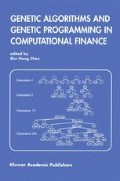Abstract
This study examines the potential of an evolutionary automatic programming methodology, Grammatical Evolution, to uncover a series of useful technical trading rules for market indices. A number of markets are analysed; these are the UK’s FTSE, Japan’s Nikkei, and the German DAX. The preliminary findings indicate that the methodology has much potential.
Access this chapter
Tax calculation will be finalised at checkout
Purchases are for personal use only
Preview
Unable to display preview. Download preview PDF.
References
Allen, F. and R. Karjalainen (1999). “Using genetic algorithms to find technical trading rules,” Journal of Financial Economics, 51, 245–271.
Bauer R. (1994). Genetic Algorithms and Investment Strategies. New York: John Wiley & Sons.
Brock, W., J. Lakonishok, and B. LeBaron (1992). “Simple Technical Trading Rules and the Stochastic Properties of Stock Returns,” Journal of Finance, 47(5), 1731–1764.
Brown, S., W. Goetzmann, and A. Kumar (1998). “The Dow Theory: William Peter Hamilton’s Track Record Reconsidered,” Journal of Finance, 53(4), 1311–1333.
Chan, L. K.C., N. Jegadeesh, and J. Lakonishok (1996). “Momentum strategies,” Journal of Finance, 51(5), 1681–1714.
Deboeck G. (1994). “Using GAs to Optimise a Trading System,” in G. Deboeck (ed.), Trading on the Edge: Neural, Genetic and Fuzzy Systems for Chaotic and Financial Markets. New York: John Wiley & Sons.
Dissanaike, G. (1997). “Do Stock Market Investors Overreact?,” Journal of Business Finance and Accounting (UK), 24(1), 27–50.
Glassman, R. (1973). “Persistence and Loose Coupling in Living Systems,” Behavioral Science, 18, 83–98.
Iba H. and N. Nikolaev (2000). “Genetic Programming Polynomial Models of Financial Data Series,” in Proceedings of CEC 2000, 1459–1466. IEEE Press.
Koza, J. (1992). Genetic Programming. MIT Press.
Lewin, B. (2000). Genes VII. Oxford University Press.
Murphy, J. J. (1999). Technical Analysis of the Financial Markets. New York: New York Institute of Finance.
Neely, C., P. Weiler, and R. Dittmar (1997). “Is Technical Analysis in the Foreign Exchange Market Profitable? A Genetic Programming Approach,” Journal of Financial and Quantitative Analysis, 32(4), 405–428.
O’Neill M. (2001). “Automatic Programming in an Arbitrary Language: Evolving Programs with Grammatical Evolution;” Ph.D. thesis. University of Limerick.
O’Neill M. and C. Ryan (2001). “Grammatical Evolution,” IEEE Transactions on Evolutionary Computation.
O’Neill M., A. Brabazon, C. Ryan, and J. J. Collins (2001). “Evolving Market Index Trading Rules Using Grammatical Evolution,” LNCS 2037, Applications of Evolutionary Computation: EvoWorkshops 2001, 343–352. Springer.
O’Sullivan J. and C. Ryan (2002). “An Investigation into the Use of Different Search Strategies with Grammatical Evolution,” in Proceedings of EuroGP′2002, In print.
Pring, M. (1991). Technical Analysis Explained: The Successful Investor’s Guide to Spotting Investment Trends and Taming Points. McGraw-Hill.
Refenes, A. N., Y. Bentz, D. W. Bunn, A. N. Burgess, and A. D. Zapranis (1997). “Financial Time Series Modelling with Discounted Least Squares Backpropagation,” Neurocomputing, 14, 123–138.
Ryan C., J. J. Collins, and M. O’Neill (1998). “Grammatical Evolution: Evolving Programs for an Arbitrary Language,” LNCS 1391, Proceedings of EuroGP′98, 83–95. Springer-Verlag.
Zhang, J., E. B. Martin, A. J. Morris, and C. Kiparissides (1997). “Inferential Estimation of Polymer Quality Using Stacked Neural Networks,” Computers and Chemical Engineering, 21 (Supplement), 1025–1030.
Author information
Authors and Affiliations
Editor information
Editors and Affiliations
Rights and permissions
Copyright information
© 2002 Springer Science+Business Media New York
About this chapter
Cite this chapter
O’Neill, M., Brabazon, A., Ryan, C. (2002). Forecasting Market Indices Using Evolutionary Automatic Programming . In: Chen, SH. (eds) Genetic Algorithms and Genetic Programming in Computational Finance. Springer, Boston, MA. https://doi.org/10.1007/978-1-4615-0835-9_8
Download citation
DOI: https://doi.org/10.1007/978-1-4615-0835-9_8
Publisher Name: Springer, Boston, MA
Print ISBN: 978-1-4613-5262-4
Online ISBN: 978-1-4615-0835-9
eBook Packages: Springer Book Archive

